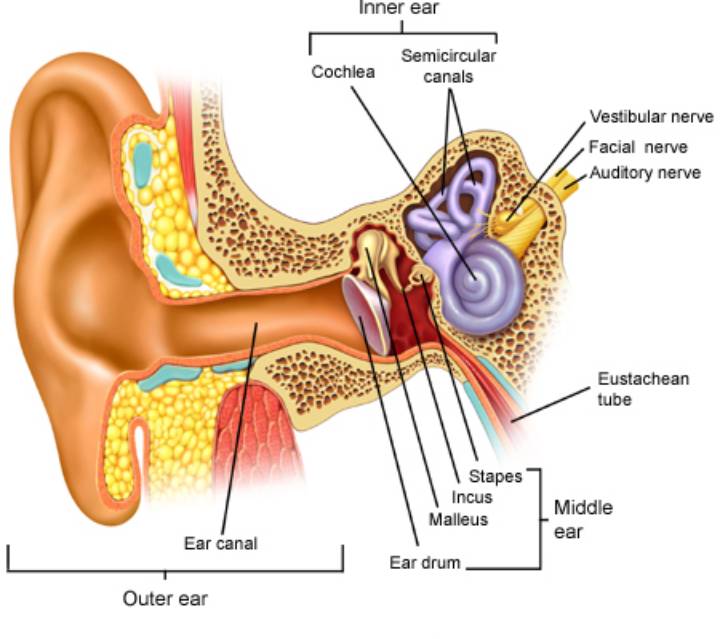Human ear - Anatomy
The ear has external, middle, and inner portions. The outer ear is called the pinna and is made of ridged cartilage covered by skin. Sound funnels through the pinna into the external auditory canal, a short tube that ends at the eardrum (tympanic membrane).
Sound causes the eardrum and its tiny attached bones in the middle portion of the ear to vibrate, and the vibrations are conducted to the nearby cochlea. The spiral-shaped cochlea is part of the inner ear; it transforms sound into nerve impulses that travel to the brain.
The fluid-filled semicircular canals (labyrinth) attach to the cochlea and nerves in the inner ear. They send information on balance and head position to the brain. The eustachian (auditory) tube drains fluid from the middle ear into the throat (pharynx) behind the nose.
RECOMMENDED
Ear Conditions
Earache: Pain in the ear can have many causes. Some of these are serious, some are not serious.
Otitis media (middle ear inflammation): Inflammation or infection of the middle ear (behind the eardrum). Usually, this is caused by an infection.
Swimmer’s ear (Otitis externa): Inflammation or infection of the outer ear (pinna and ear canal). Sudden cases are usually infections; chronic otitis is often a skin condition (dermatitis).
Meniere’s disease: A condition in which the inner ear on one side malfunctions. Vertigo, tinnitus, hearing loss, and pain are common symptoms.
Tinnitus: Ringing in one or both ears. Usually this is due to damage from noise exposure, or from aging.
Cerumen (ear wax) impaction: Ear wax may block the ear canal and adhere to the eardrum. The eardrum’s reduced vibrations impair hearing.
Ruptured eardrum: Very loud noises, sudden changes in air pressure, infection, or foreign objects can tear the eardrum. The small hole usually heals within a few weeks.
Acoustic neuroma: A noncancerous tumor that grows on the nerve traveling from the ear to the brain. Hearing loss, vertigo, and tinnitus can be symptoms.
Mastoiditis: Infection of the mastoid bone, just behind the ear. Mastoiditis can result from untreated middle ear infections.
Benign paroxysmal positional vertigo (BPPV): A disruption of function in the inner ear, causing episodes of vertigo. Although not medically serious, its symptoms can be distressing.
Cholesteatoma: This is a benign condition. It is the abnormal buildup of skin within the middle ear and surrounding bones. Often there is a foul smelling discharge associated with hearing loss. The condition usually requires surgery in order to prevent hearing loss.
Ear Tests
Ear exam: The first test for an ear problem is often just looking at the ear. An otoscope is a device to look into the ear canal to see the drum.
Auditory testing: An audiologist formally examines a person’s hearing in each ear, using sounds of varying volume and frequency.
Computed tomography (CT scan): A CT scanner uses X-rays and a computer to create images of the ears and surrounding structures.
Magnetic resonance imaging: Using radio waves in a magnetic field, a scanner creates high-resolution images of the ears and surrounding structures.
Ear Treatments
Antibiotics: If an ear infection is caused by bacteria, antibiotics (in the form of pills or ear drops) may be needed.
Cerumenolytics (ear-wax drops): Drops of a solution of mineral oil, or hydrogen peroxide and water, and other preparations can loosen impacted wax.
Irrigation (lavage): Gentle irrigation of the ear canal with salt water and diluted hydrogen peroxide can treat some cerumen impactions.
Antihistamines: A side effect of histamine blockers is a calming effect on the inner ear, reducing symptoms of vertigo.
Surgery: An operation may be necessary to remove an acoustic neuroma. Children with frequent ear infections may undergo surgery to place drainage tubes.
Positional exercises: Certain exercise regimens may improve BPPV symptoms by helping the particles in the inner ear move around.


